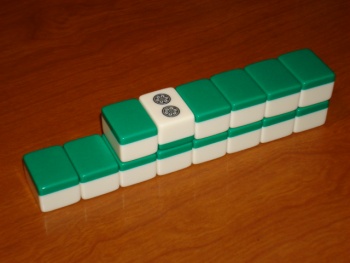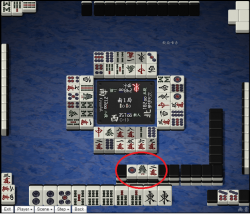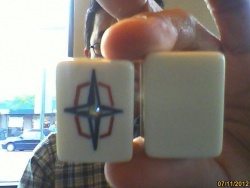Dora

Dora 「ドラ」[n 1] are special tiles; each dora in your hand grants 1 han. However, hands still require at least one yaku in order to score. Dora do not count towards the yaku requirement, so they are best considered as a bonus.
At the beginning of every hand, fourteen tiles are set aside as the dead wall tiles. A tile in the dead wall is flipped over, and the tile numerically after the flipped tile is the dora. For example, if 2-pin is flipped over, then 3-pin is the dora itself. Additional dora may be revealed through kan, known as kandora. Also, hands that declare riichi may score extra uradora.
In English, dora are also sometimes called bonus tiles or lucky tiles.
Dora Indicators
Every time tiles are dealt, fourteen tiles are set aside to form the dead wall, or wanpai 「王牌」. One of these tiles - the third from the initial wall break, as shown in the picture - is always flipped over to indicate the dora. The tile sequentially after the flipped "dora indicator" is the dora itself. For example, if 1-man is the dora indicator, then 2-man is the dora itself.
The following lists the complete dora order. Note that the order loops around, and that doras do not "cross-indicate" tiles of another suit.
Suit order
Wind order
The wind order follows the same order as the seat winds in the same counter-clockwise direction as the normal turn order.
Dragon order
Mnemonics
As the dragon order is the most arbitrary and hardest to remember, there are various mnemonics to remember them.
- In Japan, it is commonly said that the three tiles symbolize archery. The white tile symbolizes an empty target, hatsu 「發」 (lit. "release", written as 発 in modern Japanese) symbolizes the archer releasing an arrow, and chun 「中」 (lit. "middle") symbolizes the arrow hitting the middle of the target. This corresponds with the dragon order, including the tradition of putting white first.
- When green is put first (green-red-white),
- the tiles are in alphabetical order in English,
- their designs are ordered from complicated to simple.
- When red is put first (red-white-green), the order resembles a traffic light in many countries.
- Any mnemonic involving the letters WGR, GRW or RWG can be used, such as "the dragons grow."
Multiple Dora
Dora stack; a hand can have as many dora as it can fit into the hand.
In the event a dora indicator is repeated, then the dora tile will be worth one han per dora indicator.
Examples:
- Dora indicators
- Dora indicator
A single ![]() is worth 2 han - one as a regular dora, one as an akadora.
is worth 2 han - one as a regular dora, one as an akadora.
Other types of dora
During the game, you may find additional sources of dora.
Kandora

After a call for kan, an additional dora indicator is flipped. Specifically, the tile next to the dora indicator counter-clockwise on the dead wall is flipped. These are known as kandora 「カンドラ」.
The kandora timing can vary by ruleset:
- Option A is to flip the kandora indicator immediately after any kan.
- Option B (found in many online rulesets) is to flip the kandora indicator immediately after a closed kan. For open kans (both daimiminkan and shouminkan), the indicator is instead revealed after a discard or another kan.
Uradora
Uradora 「裏ドラ」, or underneath dora, are used whenever a hand wins with riichi. Therefore, no open hand may ever have access to the ura dora. In the event that any riichi-declaring hand wins, the tiles underneath the dora indicator(s) are revealed. These newly revealed tiles serve as additional dora indicators.
For each kandora revealed, the hand gets an additional uradora indicator. These are known as kanuradora 「カン裏ドラ」.
Akadora

Akadora 「赤ドラ」, akapai 「赤牌」, or red dora are tiles marked in red. Unlike dora indicators, having the red tile itself in your hand counts as a dora.
Akadora are frequently included in games, but are not universal. The most common rule is to include three red fives, one of each suit.
Most modern mahjong sets will include an extra red 5p (in total: two red 5p, one red 5m/5s). Sets may include other tiles marked "red" as automatic dora. Five happens to be the common choice because it is the center number within the 1 through 9 range. Though rarely found, some older sets include a "red haku" tile (white dragon), with some marking not present on the usual haku tile, and some sets include red threes.
An akadora used as a dora indicator is treated as a regular tile.
Nukidora
In some rulesets, especially of three-player mahjong, the North, flowers or other tiles may be used as a special dora. When a nukidora 「抜きドラ」 tile is obtained, the player may call it, set the tile aside face-up, and the hand gains 1 dora. Then, the player gets a dead wall draw. Nukidora tiles in the hand do not provide dora.
The call for a North nukidora is pei nuki 「北抜き」, or pei 「北」 ("North") for short. It is commonly called kita on English-localized mahjong platforms.[n 2]
The call for a flower nukidora is fa 「ファ or 花」.
Strategy
Dora tiles are valuable due to their +1 han. Until mangan, each han will roughly double your score, so even one dora is a substantial score boost.
Because of their value, the dora itself, as well as tiles around the dora, are generally more dangerous to discard.
Rule variations
Rules variations differ on the use of dora.
- The initial dora is the most common - it is generally universal within Japanese mahjong.
- Kandora and uradora may be excluded in some rulesets, but it is common to use both.
- Akadora is the most optional, with many rules enabling/disabling them. Mahjong tile sets are often sold with red fives in addition to four regular fives of each suit.
Notes
- ↑ The term dora is an abbreviation of the English word dragon, which is pronounced doragon in Japanese. Dora tiles are not to be confused with the sangenpai, which are called dragon tiles in English mahjong terminology, despite them having no association with dragons in Japan and China.
- ↑ On platforms like Mahjong Soul and Riichi City, the button and on-screen announcement for this call in the Japanese interface say pei nuki 「北抜き」 (lit. "taking out a North"), and the Japanese character voices will usually call "pei" (or sometimes "pei nuki" or "nukidora"), while the English interface says kita.
Kita is the regular Japanese word for north, whereas pei is the Japanese name of the North tile in mahjong, borrowed from Mandarin Chinese. Both are written as 北 in Japanese, so it is possible that "kita" originates from an error of the Mahjong Soul localisation team.
External links
- Dora in Japanese Wikipedia